Porto-North-Portugal.com
The best independent guide to north Portugal
Porto-North-Portugal.com
The best independent guide to north Portugal
Viana do Castelo: Sights, attractions and things to see in 2026
Viana do Castelo stands as one of northern Portugal's most fascinating cities, where centuries of maritime heritage blend seamlessly with pristine Atlantic beaches and authentic Minho character.
The city sits at the mouth of the Lima River and served as a shipbuilding center during the Age of Discovery, later becoming an important port for trading cloth, cod, and wine. Viana do Castelo's prosperity, which peaked in the late 17th century, is reflected in its grand plazas, ornate churches, and elegant baroque buildings.
Down at the waterfront, the working fishing harbour maintains the close connection to the sea, while contemporary buildings by Pritzker Prize-winning architects add bold modern statements. Standing high above the city is the gleaming Santuário de Santa Luzia providing breathtaking panoramic views that alone justify the journey up here.
This guide covers all of Viana do Castelo's essential sights and attractions, helping you make the most of your visit to this distinctive northern Portuguese city.
Related articles: Day trip to Viana do Castelo
Overview of the major sights of Viana do Castelo
Full details of each of these sights is provide in the final section of this guide:
Santuário de Santa Luzia - Neo- Byzantine Basilica crowning Monte de Santa Luzia with the largest rose windows on the Iberian Peninsula and 360-degree views from its dome.
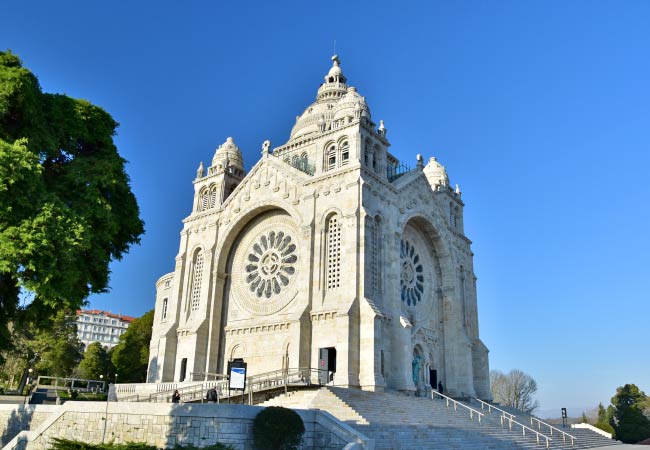
Gil Eannes - A restored 1955 hospital ship that supported Portugal's cod fishing fleet, now converted into a comprehensive maritime museum at the city docks.
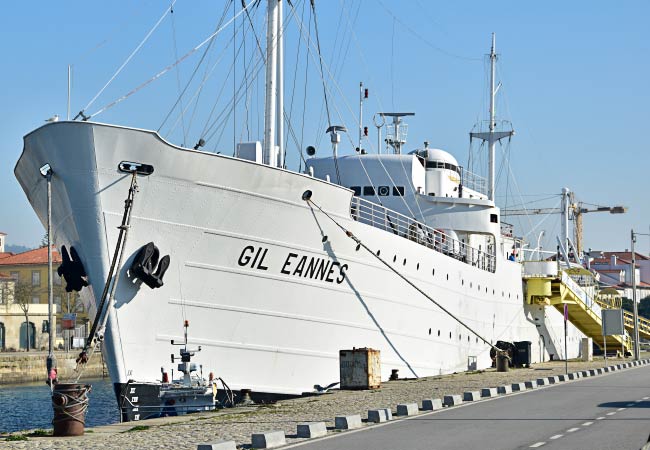
Praça da República - The city's Renaissance heart featuring a 16th-century fountain, the Gothic Old Town Hall, and the ornate Igreja da Misericórdia.
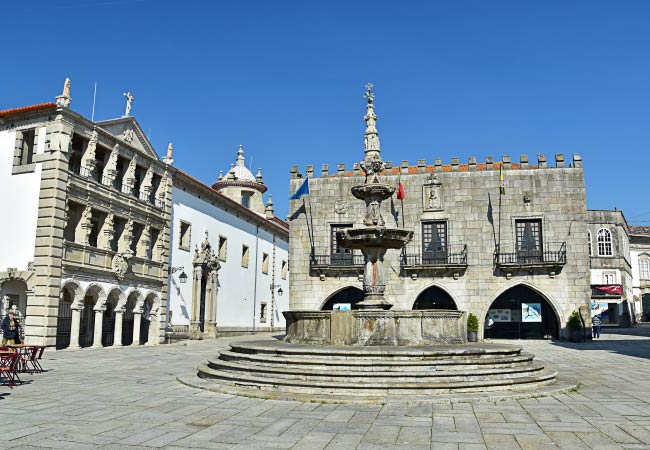
Museu do Traje - A costume museum displaying the elaborate traditional dress of the Minho region, including festival attire and gold filigree jewellery, housed in a former bank building.
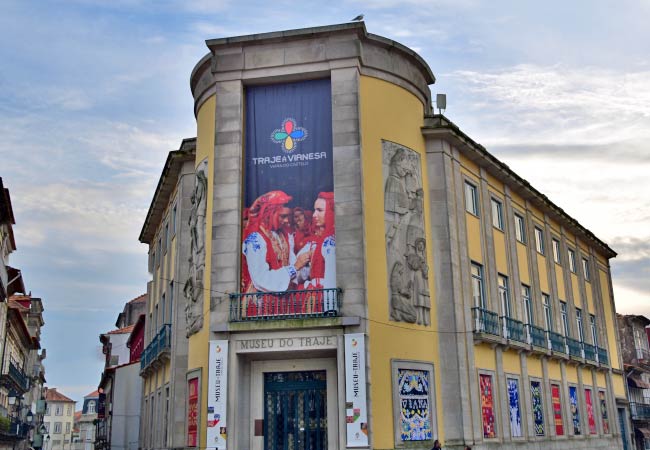
Citânia de Santa Luzia - Iron Age fortified settlement dating from the 1st century BCE, offering both archaeological interest and spectacular views from Monte de Santa Luzia.
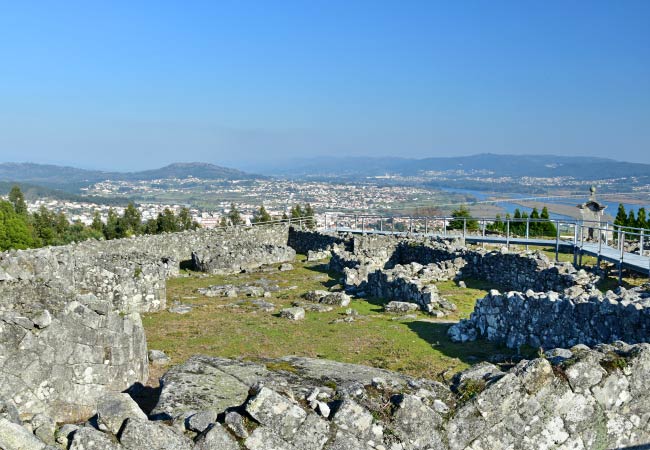
Historic Centre - A compact grid of cobbled streets filled with 16th-century manor houses, traditional shops, and architectural details from Viana's Golden Age.
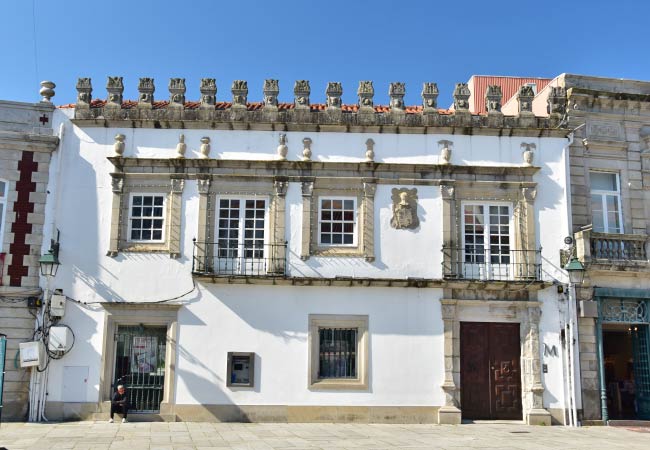
Igreja da Misericórdia - Renaissance church on Praça da República renowned for its interior of blue azulejo tiles and gilded baroque woodwork.
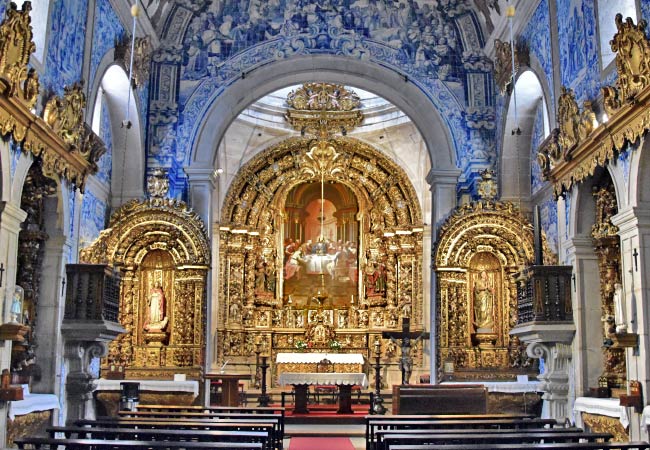
Forte de Santiago da Barra - Star-shaped 16th-century fortress guarding the river mouth where the Lima meets the Atlantic Ocean.
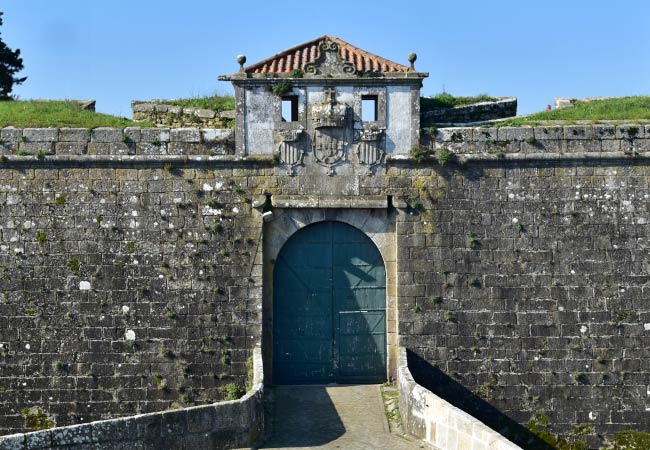
Elevador de Santa Luzia - Portugal's longest funicular railway, operating since 1923 and climbing 160 meters to connect the city center with the hilltop sanctuary.
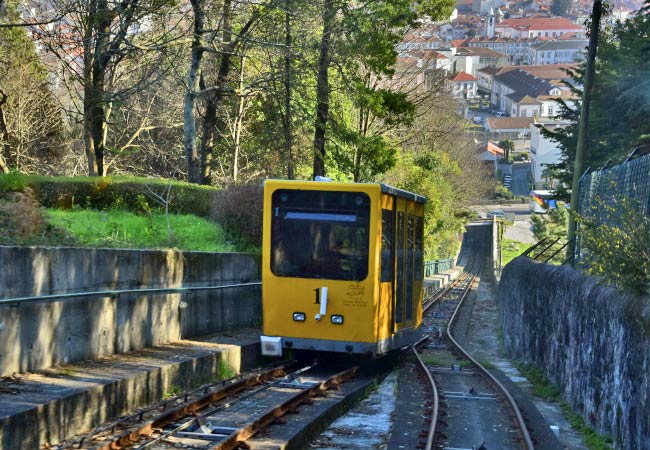
Ponte Eiffel - Double-decker iron bridge designed by Gustave Eiffel's company in 1878, carrying both road and rail traffic across the Lima River.
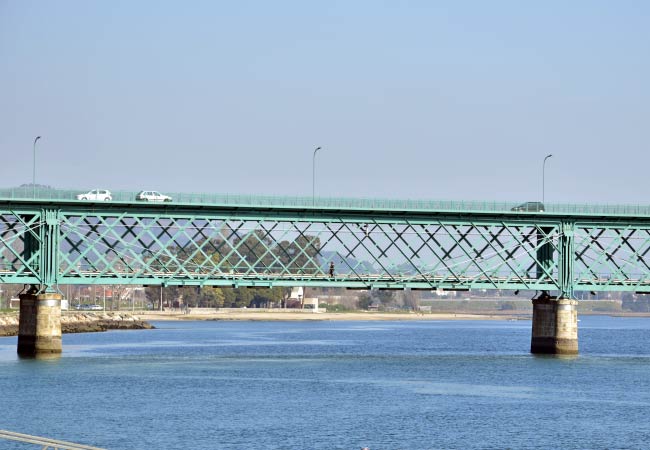
Praia do Cabedelo - Expansive Atlantic beach south of the river, renowned for kitesurfing and windsurfing conditions with consistent winds and quality waves.

Map of Viana do Castelo's attractions
The following map shows the locations of Viana do Castelo's main attractions. Most sights within the historic center lie within easy walking distance of each other, though reaching the hilltop sanctuary requires either the funicular, driving, or a steep climb. The yellow marks show some of the best restaurants in Viana do Castelo, and are detailed in the next section. (Note: zoom out to see all of the points)
Legend: 1) Santuário de Santa Luzia 2) Gil Eannes 3) Praça da República 4) Museu do Traje 5) Citânia de Santa Luzia 6) Igreja da Misericórdia 7) Forte de Santiago da Barra 8) Elevador de Santa Luzi 9) Ponte Eiffel 10) Praia Norte 11) Praia do Cabedelo 12) Santuário de Nossa Senhora 13) Igreja de São Domingos 14) Sé Catedral
Restaurants: 15) Tasquinha da Linda 16) Camelo 17) Casa d'Armas 18) Laranjeira 19) Casa Primavera 20) O Grelhador
Viana do Castelo's best restaurants
Tasquinha da Linda (Seafood / Expensive - €€€)
Located in a renovated warehouse in the fishing harbour next to the Forte de Santiago da Barra, Tasquinha da Linda is arguably the city's premier seafood destination. Its contemporary, elegant interior features large tanks displaying the day's catch, a testament to its commitment to freshness. The owners are fish wholesalers, which guarantees access to top-quality product at prices that are highly competitive for the standard offered.
Camelo (Regional / Medium - €€)
Camelo is short drive from the city centre (6km) but one of the best restaurants of the city. This bustling, family-run establishment serves quality-certified Minho cuisine in a large, tastefully decorated space that includes several dining rooms and a beautiful garden patio. Camelo is famous for its traditional specialities, particularly the iconic Bacalhau à Camelo (the house-style cod).
Casa d'Armas (Traditional / Expensive - €€€)
For a more refined and traditional fine dining experience, Casa d'Armas is a top choice. Housed in a renovated mansion near the waterfront, this restaurant has been a family-run business for decades. It is celebrated for its classic Portuguese dishes, especially seafood. Signature plates include stuffed crab (sapateira recheada), octopus with olive oil and garlic, and an unusual house bacalhau that is fried and stuffed with bacon. It is also reputed to serve one of the best versions of pudim de Abade de Priscos, an exceptionally rich crème caramel, in the country.
O Laranjeira (Traditional / Medium - €€
)
O Laranjeira offers the best of both worlds: it is Viana's oldest guesthouse (pensão) and serves some of the finest traditional Minho cuisine, yet its decor is bright and modern, and its presentation is sophisticated. Now in the hands of the third generation of the founding family, the restaurant successfully innovates while respecting tradition.
Casa Primavera - Taberna Soares (Tasca / Inexpensive - €)
This is the quintessential Portuguese tasca, a simple, family-run eatery that offers an authentic and delicious taste of local life. Frequented by fishermen and locals, Casa Primavera is known for its bustling atmosphere, hand-painted wine jugs, and incredible value. It is the perfect spot for an unpretentious, flavourful, and memorable lunch.
O Grelhador (Traditional / Inexpensive - €)
Another gem for those seeking authentic food at an unbeatable price, O Grelhador is a small, popular restaurant that serves a diaria (daily menu). This family business, with the wife in the kitchen and the husband serving, offers generous portions of fresh, well-cooked food that changes daily.
Detailed descriptions of Viana do Castelo's sights
Santuário de Santa Luzia
The Santuário de Santa Luzia commands attention from every angle of approach to Viana do Castelo. This neo-Byzantine Basilica took 55 years to complete, with construction beginning in 1904 and finishing only in 1959. Architect Miguel Ventura Terra drew inspiration from the Sacré-Cœur in Paris, creating a monument that combines Romanesque revival elements with Byzantine influences.
The church's most striking features are its two rose windows, the largest on the Iberian Peninsula, which flood the interior with coloured light. The main facade displays intricate stone carving, while the interior features granite columns and vaulted ceilings that create excellent acoustics for religious services.
For €2, visitors can climb the narrow staircase within the central dome to reach one of Portugal's finest viewpoints. The 360-degree panorama encompasses the entire Lima valley, the Atlantic coastline, and on clear days, the mountains of Galicia. The climb requires reasonable fitness and comfort with confined spaces, as the staircase becomes progressively narrower near the top.
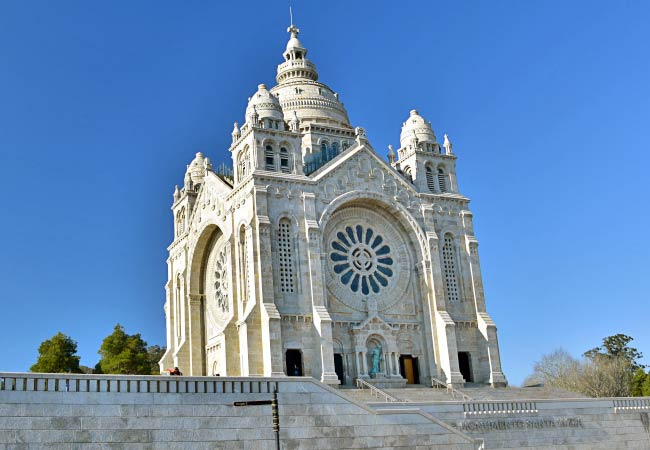
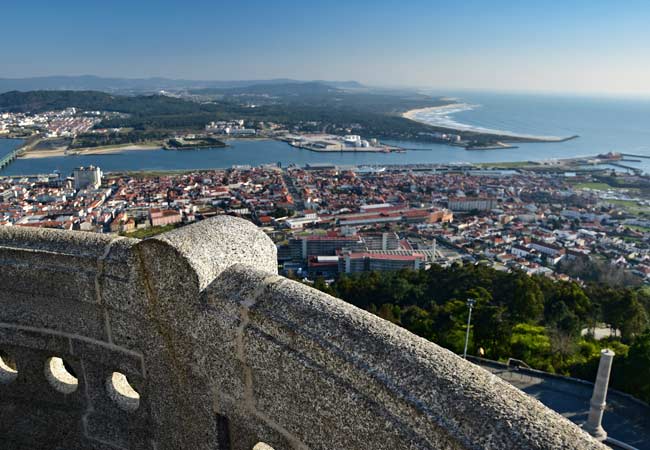
Gil Eannes
The Gil Eannes hospital ship provides direct insight into Portugal's 20th-century cod fishing industry. Built in Viana do Castelo's shipyards in 1955, this vessel served multiple crucial roles until 1963: floating hospital, icebreaker, and supply ship providing provisions and bait to the Portuguese fishing fleet operating in the treacherous waters off Newfoundland and Greenland.
The ship's versatility reflected the extreme conditions of North Atlantic cod fishing. Its reinforced hull could break through pack ice to reach stranded vessels, while the onboard hospital facilities treated everything from frostbite to severe injuries. The supply role proved equally vital, delivering food, medical supplies, and fishing bait to fleets that spent months at sea.
The ship's preservation resulted from remarkable community effort. After decommissioning, the Gil Eannes was sold for scrap and sat deteriorating until 1997, when a municipal campaign rescued the vessel and returned it to its birthplace.
Visitors can explore all areas of the ship, from the bridge and engine room to the medical facilities. The operating theatre, x-ray room, and consultation areas remain remarkably intact, complete with period medical equipment. The crew quarters and officers' mess demonstrate the stark differences in accommodation aboard the vessel.
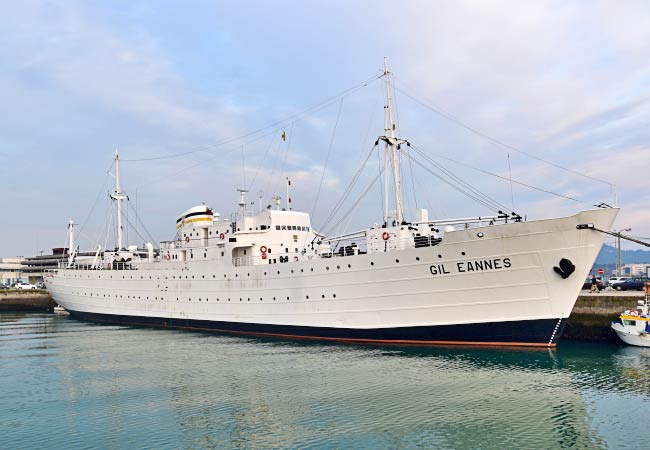
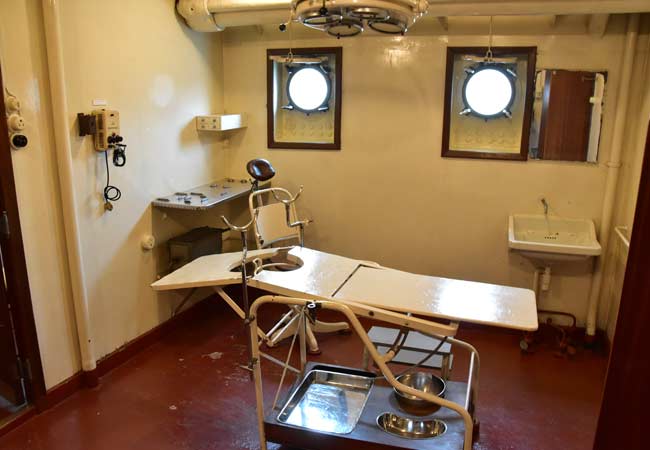
The operating room was at the lowest point of the ship, to have the least movement during rough seas
Praça da República
Praça da República forms the architectural centrepiece of Viana do Castelo's historic district. This Renaissance square dates from the city's 16th-century golden age, when maritime trade brought considerable wealth to local merchants and nobility.
The square's focal point is the Chafariz fountain, an elegant Renaissance structure built by João Lopes the Elder. Its design follows contemporary Italian taste with water falling from graduated basins, a sophisticated engineering feat that demonstrated Viana's cosmopolitan connections and prosperity.
The Antigos Paços do Concelho (Old Town Hall) displays Gothic architecture with a distinctive three-arched arcade at ground level that once sheltered market activity. The building's restored stonework and proportions create perfect harmony with the surrounding Renaissance ensemble.
The extraordinary Igreja da Misericórdia dominates one side of the square with its unique three-story facade. João Lopes' granite caryatids have supported the upper levels since 1520, surviving even when the church underwent major reconstruction two centuries later.
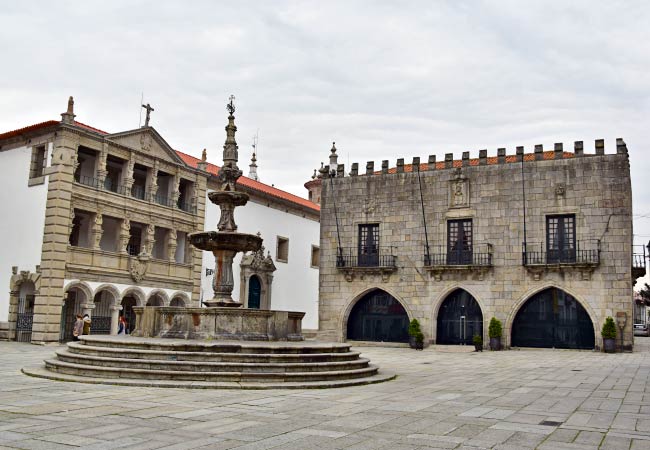
Igreja da Misericórdia
The Igreja da Misericórdia occupies a prominent position on Praça da República. Built in the 16th century the church served the Santa Casa da Misericórdia, a charitable brotherhood that provided medical care and social support.
The church's exterior gives little indication of the baroque splendour within. The interior walls display exceptional azulejo work begun in 1720 by António de Oliveira Bernardes, one of Portugal's master tile painters. These biblical scenes, though grand in scale, were completed by António's son Policarpo, who maintained the quality if not quite the nobility of his father's vision.
The ceiling and altar showcase Talha Dourada, the intricately carved and gilded woodwork that characterises Portuguese baroque church interiors. Gold leaf covers every surface of the altar, creating an overwhelming display of religious devotion expressed through material richness. The contrast between the blue tiles and golden woodwork produces a uniquely Portuguese aesthetic that took two generations of craftsmen to complete.
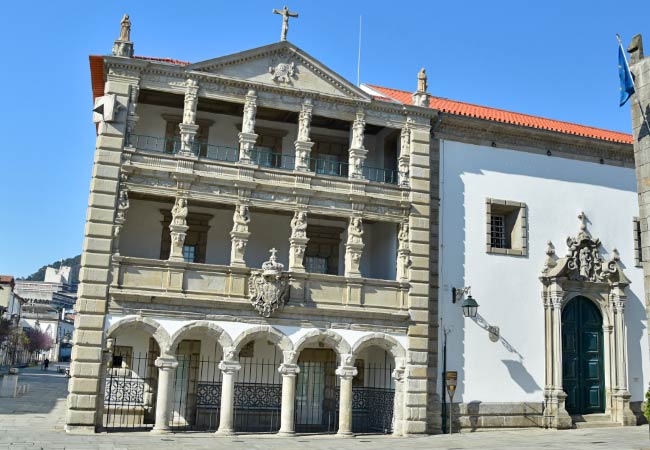
Museu do Traje
The Costume Museum occupies the imposing former Bank of Portugal building. The museum's collection focuses on the elaborate traditional costumes of the Minho region, which remain among Portugal's most distinctive folk dress.
Displays demonstrate how different garments combined to create ceremonial, work, and mourning attire. The Traje de Mordoma worn by festival stewards during the August Romaria displays exceptional embroidery and colour. The black Traje de Noiva (wedding dress) challenges expectations about bridal wear while reflecting regional traditions.
The museum explains the complex visual language encoded in traditional dress. Colours, embroidery patterns, and accessories communicated the wearer's marital status, economic position, and village of origin. This system functioned as a form of non-verbal communication understood throughout the region.
The former bank vault now houses an extensive collection of traditional Minho gold jewellery. The delicate filigree work on display represents centuries of craft tradition, with pieces ranging from simple crosses to elaborate necklaces and earrings.

Citânia de Santa Luzia
The Iron Age Castro (fortified settlement) sists adjacent to the Santa Luzia. It dates from the 1st century BCE and continued through the Roman period, making it one of the region's most significant archaeological sites.
The settlement's strategic position becomes immediately apparent when walking among the ruins. The inhabitants commanded views over the Lima estuary, the Atlantic approach, and inland valleys, perfect for controlling trade and detecting threats.
Circular stone foundations mark individual dwellings, with walls surviving to knee height in most areas. The typical Castro house plan featured a single round room with a central hearth, though some structures show evidence of internal divisions. Archaeologists have identified approximately 50 individual buildings within the fortified area.
The settlement's relationship with the later Christian sanctuary creates compelling historical continuity. Both cultures recognized the hill's strategic and possibly spiritual significance, layering their monuments on the same ground.
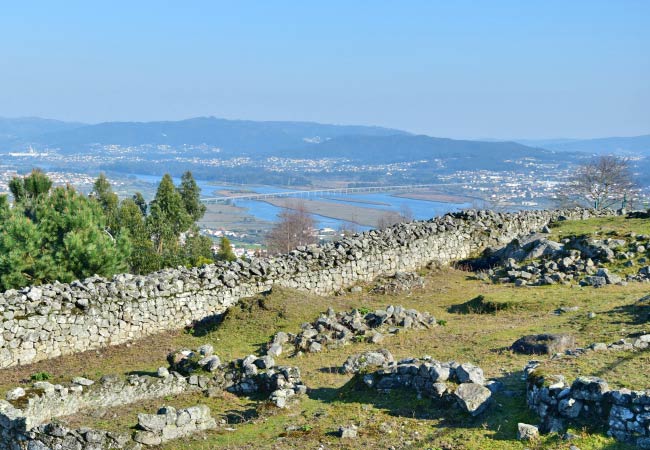
Historic Centre
Viana do Castelo's historic center rewards slow exploration through its network of narrow streets and small squares. The district follows a rough grid pattern that aids navigation while preserving the medieval street width.
Architectural details reveal the city's prosperous past at every turn. Manueline windows featuring carved rope motifs and armillary spheres mark 16th-century construction. Baroque additions from the 17th and 18th centuries added decorative ironwork balconies and carved granite doorways. Many buildings display family coats of arms above entrances, indicating the noble residences that once dominated these streets.
This architectural wealth stems from Viana's golden age as northern Portugal's principal port. Between the 16th and late 17th centuries, English and Scottish merchants established themselves in baroque townhouses throughout these streets, trading cloth and cod for the region's wine.
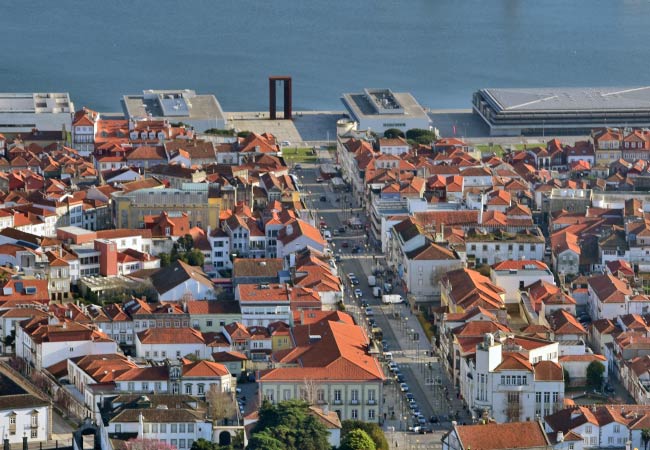
The city thrived on international trade with England, Brazil, Scandinavia, and Russia until merchants discovered it was easier to ship wine from the Upper Douro via Porto. This shift ended Viana's commercial dominance but inadvertently preserved its Renaissance and baroque character, as the city avoided the industrial development that transformed other ports.
The Casa de Sá Soutomaior and Casa dos Luna represent the finest surviving examples of Renaissance domestic architecture. These manor houses feature elaborate window surrounds, interior courtyards, and carved stone details that demonstrate their owners' wealth and taste.
Rua da Bandeira serves as the main commercial artery, mixing traditional shops with modern boutiques. Family-run establishments selling regional products occupy ground floors of historic buildings, maintaining commercial continuity stretching back centuries. The street's name commemorates the flag bearers who led religious processions along this route.
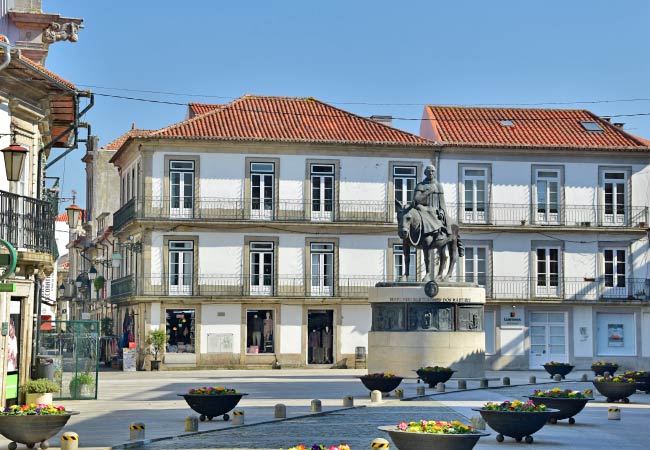
Forte de Santiago da Barra
The star-shaped fortress at the Lima River mouth represents military engineering from the age of Spanish rule. Philip II of Spain, during his reign as King of Portugal, ordered the fort's construction in 1592 to protect Viana's valuable port from pirates eager to plunder merchant vessels laden with goods from international trade.
The fortress controlled access to Viana do Castelo's port during the city's peak as northern Portugal's principal harbour. Its position allowed defenders to engage hostile ships attempting to enter the river while protecting the merchant fleet that generated the city's considerable wealth through trade.
Walking the ramparts provides excellent views over the fishing harbour, river estuary, and ocean. The massive stone walls demonstrate the engineering required to build on sandy soil near the river mouth. The fort's continued military use into the 20th century preserved its structure while preventing tourist development.
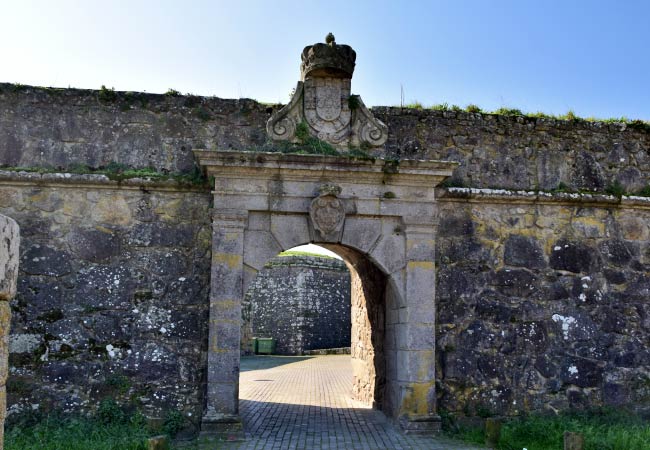
Ponte Eiffel
The iron railway bridge spanning the Lima River represents is a marvel of 19th-century engineering. Completed in 1878 by Gustave Eiffel's company, the structure carries both rail traffic on its upper deck and road vehicles below. The engineering achievement becomes apparent when considering the technical challenges.
The Lima River's sandy bottom required deep foundations, while the span needed sufficient height for maritime traffic to pass beneath. The solution employed the latest iron construction techniques, creating a structure that remains fully functional after nearly 150 years.
Elevador de Santa Luzia
The scenic journey to the Santuário de Santa Luzia is an experience in itself, thanks to the Elevador de Santa Luzia. This funicular is Portugal's longest, with a track length of 650 metres. It also overcomes the greatest elevation change of any such system in the country, rising 160 metres from its base to the summit. The track includes several impressive bridges spanning small valleys and one section tunnelled through solid rock, offering varied and beautiful views as you ascend.
The ride on the funicular takes seven minutes to reach the top, and costs €2 for a one-way ticket or €3 for a return.

Atlantic Beaches
Praia do Cabedelo stretches south of the Lima estuary in a vast arc of golden sand backed by dunes and maritime pine forest. The beach's exposure to Atlantic swells and reliable afternoon winds creates ideal conditions for kitesurfing and windsurfing, attracting practitioners from across Europe.
Praia Norte offers a different beach experience closer to the city center. Rocky outcrops divide the sand into smaller bays, providing natural windbreaks and creating varied environments. The beachfront promenade connects cafes, bars, and restaurants, supporting a more urban beach culture.
Both beaches hold Blue Flag status, indicating high water quality and environmental management standards. Lifeguard services operate during summer months, though Atlantic conditions always demand respect regardless of supervision. Strong currents and powerful waves can develop rapidly.
If you've found our content valuable, we'd welcome your support.
The digital publishing landscape has evolved significantly. As a small independent publisher, we face growing challenges. Search engines increasingly favour paid content over organic results, while AI-generated content often reproduces original work without attribution.
To support our work, please consider bookmarking this page (press Ctrl + D) for quick access. If you find an article helpful, we'd be grateful if you'd share it with friends on social media.
For specific questions, please see our Reddit community at r/LisbonPortugalTravel.
Should you notice any outdated or incorrect information, please contact us at [email protected]
Thank you for helping us continue to provide valuable content in an increasingly challenging digital environment.






















